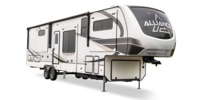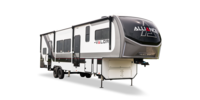The snow might be falling, but it’s the only time of the year to go winter camping in your RV. Winter RV camping is the best way to experience the beauty and tranquility of the season in the great outdoors, but that means gearing-up with the right equipment and knowledge to keep your rig up-and-running when the temperature drops.
Learn everything you need to know for extending the RV camping season through the winter months. Find out the tips and tricks for keeping your RV warm and the water running – and everything else you need for RV camping in the cold. And, learn how to prepare for unforeseen situations with the essential winter RV emergency checklist.
Winter Camping in Your RV: How to Winterize and Prepare Your RV
One of the best parts of winter camping is the exclusive access you get to some of the best campgrounds in the Midwest, Northern, and the Eastern United States. Most of the time, you have your run of the place. And, whether you’re winter-thrill-seeking on the slopes, or boondocking your way through the season, your RV can let you see a side of the wild that few other campers enjoy.
Winter in nature can possess an almost-magical peace, but the cold temperatures, ice, and snow can quickly become a dangerous adversary to those caught in a situation for which they are unprepared. Your 5th-wheel RV, Class-C, or Toy Hauler is built for rugged terrain and the rigorous cold conditions of winter. But, no matter what type of RV you’re hauling, performing some basic RV winterization measures can help to mitigate maintenance and repairs down-the-road.
Step-by-step to Winterizing Your RVs Exterior and Interior
To any warm-blooded mammal, living in a seasonal climate – winter brings out common natural tendencies to protect and prepare for the freezing temperatures, icy winds, and snow. In keeping with the seasonal tradition of nature, brace your mobile dwelling against the hazards of the cold by taking steps to winterize your RV.
How to Protect Your Holding Tanks from Freezing
For anyone new to winter camping in their RV, there is one lesson you don’t have to learn twice. If you have yet to experience the stench and surprise of trying to empty a frozen RV waste holding tank, count yourself a lucky camper. And, in the endeavor to continue your lucky streak – simple precautionary measures will ensure your RV holding tank doesn't freeze.
Before you set out, empty the contents of your black and gray water tanks. Then, to protect your RVs dump valves from freezing, pour about a quartz-worth of RV Antifreeze liquid into both tanks. If you are camping with an older RV, or in abnormally cold conditions, add some pieces of foam pipe insulation material to the tank's drainage piping.
When rubber and plastic pipes or hoses become frozen, they lose structural integrity and easily crack when they thaw. So, the name of the game is to keep your hoses and piping from the strain of temperature change. In extra-cold climates, for larger Class-C, 5th-wheel, and mobile home RVs, it might be necessary to install a holding tank heater that runs on a 12-volt DC outlet or 120-volt AC hookup.
How to Keep Your Slide-out Awning from Freezing or Jamming
One of the parts of your RV that can malfunction in winter conditions is your RVs slide-out awning. In the winter, snow and ice can build-up in the sliding mechanism of your awning, making it difficult to pull-out or retract. The awning, as well as the slide gasket, can become jammed – especially if your RV is stationary for a prolonged period of a few days, or more.
One method of clearing the accumulation of snow or ice on your awning is the same as you do with your vehicle – brush it off. But, to keep ice and snow from building up in the slide gasket, use RV antifreeze on any easily obstructed awning mechanics whenever the temperature drops to below freezing or winter precipitation are forecast.
Keep Your Water Hose, Ice Machine Line, and Water Pump from Freezing
The hose supplying fresh water to your RV is of paramount importance to winter camping. Without fresh running water, you might as well be camping in a big tent. So, make sure that your water hose doesn’t freeze-up, by upgrading to a heated AC-powered water hose for your RV.
Likewise, the water pump in your RV has to refrain from becoming frozen for water to keep pumping. It doesn't take much to keep your water pump from freezing since your RV likely insulates this hardware. The heat of your engine will keep the pump from freezing while your RV is in motion, but to be sure it doesn’t freeze after you park your RV, keep a little space heater running near your RVs water pump compartment after you set-up camp.
The other water line to check is your RVs ice machine water hose. The hose that transports freshwater into your ice machine is commonly left without insulation. If you simply wrap some thermal tape around the ice machine's water hose it is less likely to freeze or crack when the seasons change.
How to Insulate Your RV Windows and Ceiling Ventilation
The closed windows of your RV are the primary areas where cold air comes-in when you are out RV camping in the winter. Just like your home's windows, cold air likes to seep through the cracks that form overtime on the seals and borders around your RV windows. The best way to thwart the cold from leaking into your RV is to install dual-pane RV windows.
In addition to upgrading your RV’s windows, you can consider adding insulated curtains to the interior of your RV. Insulated curtains are an easy way to keep warm air in, and keep the cold air out of your sleeping areas and common space. For Class-C motorhomes, with large cockpit windows, insulated curtains are great for sequestering the rest of the RV and retaining heat.
And, when it comes to sealing-up the open areas between the exterior and interior of your RV, your RVs ceiling vents are a wide-open door for old man winter to come right in. Winterizing your ceiling vents is often as easy as installing standard vent cushions.
How to Keep Your Furnace Working and RV Interior Warm
Your RV furnace is essential to keeping you warm during your winter camping RV excursion, so make sure you give it some standard maintenance before you set-off. Wearing a safety mask, rid the furnace of accumulated dust and debris using a vacuum, rag, and can of compressed air. If your winter trip is taking you to temperatures below freezing, consider adding a few small electric space heaters to your RV, to keep down on propane usage.
Be sure to remove at least one vent cushion to refrain from too much heat building-up or condensation forming. If condensation becomes an issue in your RV, consider adding a portable dehumidifier to your RVs electric-appliance arsenal. A dehumidifier will improve the longevity of your RVs interior by preventing the corrosion process, wood rot, mildew, and mold from growing.
How to Winterize Your RVs Propane Consumption
A big difference between using your RV in the spring or summer, and using your RV in the winter is the amount of propane you go through. Propane is what your RV uses to create heat, and your RVs normal 20-gallon tanks might not last as long as they need to. If you plan on doing any extended winter camping, upgrade to 30-gallon propane tanks, and keep your old 20-gallon tanks full and stored on-board as spare tanks for emergencies.
The Essential Winter Camping RV Emergency Checklist – 2021
If you’re a lucky RVer, you won’t ever have to use your emergency winter camping gear. But, if you don’t have any emergency supplies, you better believe you are going to end up wishing you had them. The difference between being prepared for extreme situations with simple precautionary supplies and equipment can mean the difference between life or death.
All things considered, the overall cost of your winter RV emergency supplies is low. Some are one-time expenses and some are things you can round-up around your home. Others are single-use items that need to be replenished.
Keeping your RVs emergency winter essentials stocked and ready gives you the peace-of-mind to hope for the best – because you know your RV is prepared for winter's worst. Before your winter camping commences, always bring these items:
● A few days worth of dehydrated food
● Winter tire chains, for icy-road conditions
● Extra warm blankets
● Extra winter clothing
● A sub-zero-temperature-rated sleeping bag for each camper
● A battery-powered weather-band radio
● A white-gas camping stove
● Between 5 to 10 gallons of extra drinking water
● Battery-powered blow dryer
● Small gasoline-powered generator
● A package of hand-warmers
● First-aid kit
● Mobile GPS locator
Know Before You Go and Get Stuck in the Snow
Once you know that your RV is up to the cold task ahead, it’s up to you to take the next step into your winter adventure. Staying safe while camping in the winter means formulating a plan for your trip that takes into account the location, terrain, and weather expected for your time of travel. Be sure to always check the National Weather Service before leaving on your trip, to see what you can expect in the way of cold temperatures and winter precipitation.
Make sure you convey your travel plans to someone who can inform authorities if you fail to return from your trip as scheduled if you befall some unforeseen danger. And, some campgrounds shut-down for the winter months, so be sure the power will be on when you get to your campsite by calling-up the RV-park before heading-out. If you want to know more about how to prepare your RV for winter camping, talk to an RV expert today so that you can get on the road.









